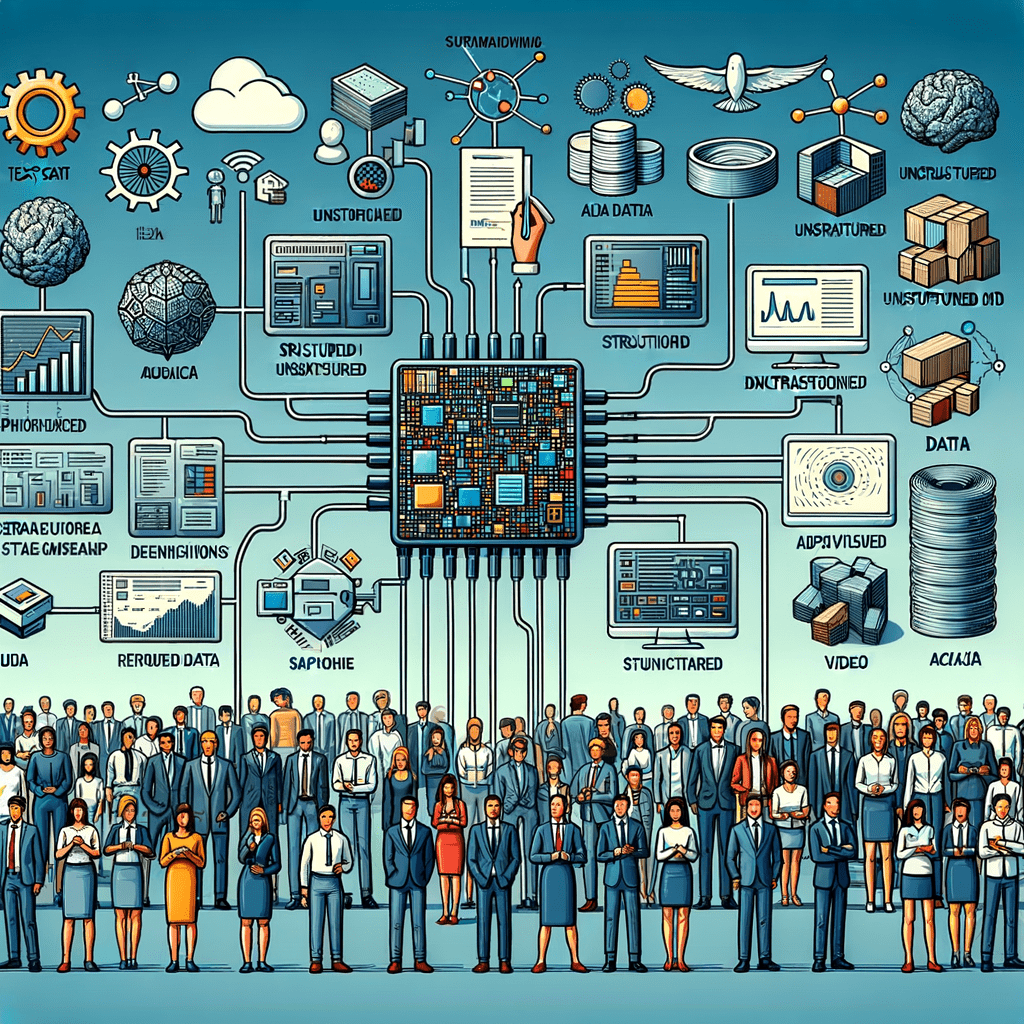So, what are the types of data in generative AI? Generative AI, the technology behind tools like ChatGPT and DALL-E 2, creates text, images, music, and code. This creative power hinges on the data it receives. Understanding this data is crucial, as it forms the core of generative AI models. This knowledge can empower you to enhance productivity and gain a competitive edge.
Data: The Foundation of Generative AI
Generative AI models, like variational autoencoders, learn by identifying patterns in data. These AI algorithms require vast amounts of data, sometimes terabytes, to generate impressive outputs. A generative AI model’s effectiveness directly relates to the quality of its training data.
Structured Data
Structured data resides in spreadsheets and databases. This organized data, comprising numbers, dates, and categories, is easily processed by AI. Structured data fuels models tackling tasks with defined parameters. It also enables financial modeling, relying on financial records as the foundation.
Unstructured Data
Unstructured data constitutes most of the world’s data. This includes text, audio, and video. Generative AI decodes this format to gain insights. Unstructured data, particularly in natural language processing, is essential for language models like GPT-4, enabling the creation of realistic images from unstructured data sources.
What are the Types of Data in Generative AI: A Breakdown
| Data Type | Description | Use Cases |
|---|---|---|
| Text | Words, sentences, paragraphs, code | Chatbots, content creation, language translation, code generation |
| Images | Photographs, drawings, digital art | Image generation, image editing, style transfer |
| Audio | Speech, music, sound effects | Music composition, speech synthesis, audio enhancement |
| Video | Movies, clips, animations | Video generation, video editing, special effects |
| Code | Programming code in various languages | Code generation, code completion, bug detection |
| Other Structured Data | Numerical and categorical data (think of sensor output or shopping behaviors). | Enhancing AI insights to assist outputs or refine existing ones. |
OpenAI’s Sora, a text-to-video model, showcases the fusion of data types. This model combines textual descriptions with visual concepts to generate video content.
Training Data vs. Input Data: Distinct Roles
Training data establishes a model’s foundational knowledge. This process is similar to a student’s education before exams. Input data, however, is like on-the-job experience, applied after training. In content generation with Bard, input data, such as text prompts and examples, guides the creation process, like crafting a college essay on quantum physics using relevant texts on quantum mechanics.
Data Quality: The Unsung Hero of Generative AI
Low-quality or poorly formatted training data yields subpar results in generative AI models. This includes flawed outputs and inaccurate models. Adversarial networks also contribute to data refinement.
Strategies for Better Data
- Curation: Selecting high-quality data, much like choosing the best ingredients, improves long-term generative AI accuracy. Hand-picking high-quality data from existing datasets plays an essential role in enhancing a generative model’s learning process and avoiding potential data biases introduced by automated selection methods.
- Cleaning and Preprocessing: Correcting errors and ensuring consistency in data prepares it for effective AI training. Data preprocessing involves data cleaning to fix inconsistencies, handling missing data by imputation, or removal, transforming the data like data normalization to remove scales or eliminate irrelevant data points.
- Augmentation: Expanding existing datasets through techniques like data augmentation and regularization enhances AI model performance. Transformations, like adding blur to photos or rephrasing sentences, create larger datasets, providing generative AI models with more examples to learn patterns and relations from, and produce richer data for adversarial network architectures. This strengthens models and enhances output dependability.
Business Applications: Data’s Impact on Real-World AI
McKinsey’s research reveals increasing organizational adoption of generative AI. Gartner projects over 80% adoption by 2026. Generative AI could contribute trillions to the global economy, benefiting businesses from small blogs to large enterprises. Various popular generative ai tools rely heavily on data types.
Real-World Examples of Data-Driven Success
Personalized marketing leverages generative AI to tailor user experiences. By combining user preferences, demographics, website behavior, and search history, businesses create personalized emails and ads, improving customer experience and boosting engagement. Personalized experiences significantly impact user engagement and conversions.
Content creation benefits greatly from generative AI and its large language models (LLMs). LLMs process large amounts of textual data, enabling content creation, rewriting, and refinement at an unprecedented pace. This streamlines workflows for content creators, including bloggers and copywriters, increasing site engagement and revenue. Furthermore, generative AI can create personalized audio content, like custom intro music for videos. What are the types of data in generative AI that enable this? The models rely heavily on large audio datasets and use training data which includes aspects like melody, harmony, and rhythm, often paired with specific parameters like desired style.
Ethical Considerations and Data Bias
Data reflects human biases, leading to prejudiced outputs in generative AI models. A lawyer’s use of generative AI in court resulted in fabricated cases, highlighting the importance of ethical data usage. Synthetic data can offer solutions in such scenarios.
Navigating a Path Toward More Ethical Considerations
Promoting diversity in data, along with careful analysis and selection of training and input data, are critical for reducing bias. Developing tools and metrics to detect and mitigate bias in AI models is essential. This proactive approach addresses prejudices and raises awareness of sensitive information handling. Government oversight plays a vital role in regulating these data systems. A business might generate synthetic training data by studying the properties of a subset of their customer’s personally identifiable information, and using this subset to train generative models which then create data with statistical similarities but without the sensitive or private data elements included. In this way, synthetic training data creates a privacy preserving outcome where learning models have large data quantities while respecting privacy.
The Future of Generative AI: Data’s Evolving Role
Generative AI’s future depends on accessing high-quality, diverse, and unbiased data. This access can unlock further potential in various fields, from art and music to medicine and mathematics. The core data types—text, images, audio, video, and code—remain crucial for generative pre-trained models. However, future AI might incorporate new data forms, like sensory experiences or location information from navigation datasets, expanding its capabilities beyond current understanding. As machine learning advances, training data could include physical sensations or abstract concepts, allowing AI models to create increasingly nuanced and unique forms of content, moving beyond simply text generation.
FAQs about what are the types of data in generative ai
FAQ 1: What type of data is used for generative AI?
Generative AI utilizes various data types, including text, images, audio, video, and code, for model training and content generation. The specific type depends on the task. For example, chatbots utilize text, image generators use images, and music composition employs audio data.
FAQ 2: What are the types of data in generative AI: structured, unstructured?
Generative AI utilizes both structured data, readily processed by AI due to its organization (like databases), and unstructured data (text and images) which requires more complex processing for meaningful extraction. Financial modeling relies on structured data like financial records while content generation leverages unstructured data like text from books. Deep learning approaches in this content generation domain allow models to find more granular relations like the phrase “what are the types of data in generative AI”.
FAQ 3: What are types of data in AI?
Beyond generative AI’s focus on text, images, audio, video, code, and structured types, broader AI data categories exist. These include time-series data, sensor data, graphs, and location data.
FAQ 4: What are the four types of generative AI?
While some debate exists, four widely recognized categories of generative AI are Generative Adversarial Networks (GANs), Variational Autoencoders (VAEs), transformer-based architectures, and diffusion models.
Wrapping Up Generative AI Data Insights
So, what are the types of data in generative AI? The data powering generative AI is its fundamental building block. From text and images to emerging forms like location and sensor data, these elements fuel generative AI’s creative potential. As AI evolves, the data it uses will continue to shape its innovative and impactful applications.
Understanding these data types empowers businesses and individuals to leverage generative AI effectively. This knowledge enhances content creation, personalizes marketing campaigns, and ultimately enriches user experiences without negatively impacting budgets.




